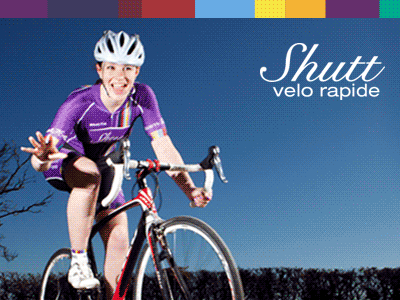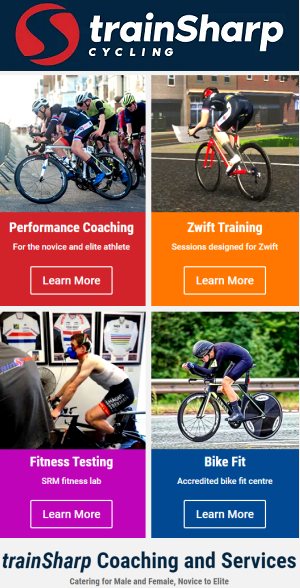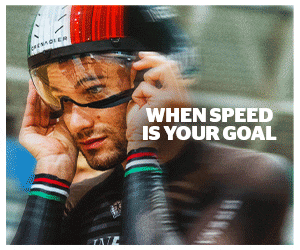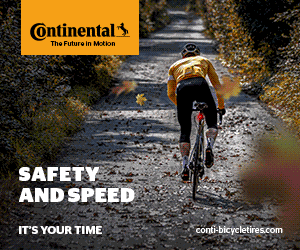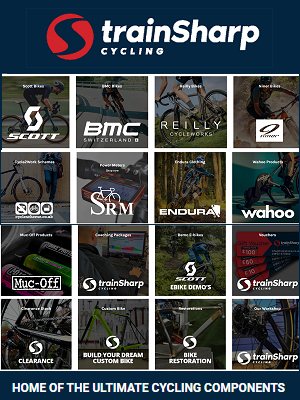trainSharp coach Connor Murphy writes about a mad ride across the South Downs Way recently which was eleven and a half hours on a mountain bike!
 |
trainSharp Feature: All Day Epic Rides!
Related Feature: Connor Murphy from trainSharp writes there are lessons highlighted by lockdown and in this article, he looks at how you can use these moving forwards
A guide to surviving an all-day epic!
Connor writes … In the current climate of no racing here in Britain, there has been a large rise in athletes completing long endurance rides of six to twelve hours!
This is likely due to us, as cyclists, feeling like we need to achieve something and with no racing, long rides are something we can do within all the current guidelines. There is a good sense of achievement when you complete a new longest ride, so it is a good goal to stay motivated until racing returns.
The biggest tip here, is to be prepared! This encompasses various aspects and as the saying goes, if you fail to prepare, you are preparing to fail! So, let’s delve into how to be prepared.
Be in the best shape possible
Being as fit as you can, will massively influence how enjoyable your epic ride will be. Having the confidence that you can push on and stay strong to the end will be one of the strongest motivators for completing your effort.
In the lead up to your ride, you should be thinking about increasing your training load, with structured and consistent training sessions.
Completing such training sessions will ensure you are the in the best possible shape for your goal event – the sooner you think about this, the more benefit it will have. There is little point in starting to train hard two weeks before your ride so think about a minimum of 12 weeks to allow improvements in performance. A trainSharp coach can help to guide you through this process and can give you support in all aspects of your training.
Pace yourself!
Pacing yourself will be one of the biggest factors affecting whether you achieve success or ultimately fail. It is simple to think, ‘ah I’ll just go out easy’ but we often get carried away, go out too hard and end up paying for it later in the ride. So, you will probably be wondering, ‘how will I know what pace to ride at’?
The answer to that can come from a few angles; a more basic approach, or a scientific data driven approach.
Let us begin with the simple one. To keep it simple, your all-day riding pace is likely to be somewhere in-between zone 1 and 2, at most the top of zone 2. At this intensity, you should be able to string complete and coherent sentences together, so if you can have a comfortable conversation, that is more than likely about right.
Now for the more scientific approach. When we test in the trainSharp Lab during a Lactate step test, we are looking for two lactate thresholds (LT), LT1 and LT2. Now, LT1 is what we are interested in here, it is the blood marker which occurs at an intensity whereby the lactate measured in the blood will not increase in a steady state effort. So, in theory, with the correct fuelling, LT1 is your maximum all day riding pace.
This marker occurs at the top of zone 2 generally. So, in this case, understanding what power and/or heart rate this occurs at, will be a good marker for your absolute maximal all day riding pace.
… continued after advert
Eat, eat and eat some more
Fuelling and hydration are another two big factors which will influence your success. At the kind of intensity described above, you will be burning a mixture of carbohydrates and fats, this will differ depending on the intensity of the ride and will also be affected by the metabolic flexibility of the rider; so very individual.
For arguments sake, lets assume you will be burning 50% fats and 50% carbohydrate. This is where fuelling becomes critically important. You effectively have a limitless supply of fat stores, but only around 90 minutes worth of muscle glycogen, this is why you must refuel.
The guidance here has historically been 60-90g of carbohydrate per hour. This is generally affected by gastrointestinal issues (GI). Moving forwards, there is new research suggesting more carbohydrate (towards 120g/hour) may be beneficial, but this should be approached with caution.
Mix up your food too, lots of sweet foods will cause GI issues for some riders, so adding savoury foods will help this. Also, practicing with these foods is critical, do not leave it to the day of your event to decide you don’t like the flavour of the gels you have packed etc.
With regards to hydration, drinking to thirst is generally good advice. But think about adding a carbohydrate/electrolyte mix to this, to add carbohydrate and replace any minerals lost through sweating etc.

Pack all the tools you could need and prepare the bike appropriately
With all day epic rides, chances are you will be miles from home, so being prepared for all eventualities is important. Just like with any ride, you should always pack the essentials, but for your epic, you may want to think about an extra couple of spares.
It is possible that you are thinking you would want to pack light, but that is a mistake and could be a ride fail waiting to happen. Pack everything you think you will need and more!
Another simple tip and a rather obvious one, is to make sure the bike is in full working order and any mishaps have therefore been pre-empted. For example, are there any cuts in your tyres or is your chain worn? Worth checking!
Plan your route in advance
The final tip in this article revolves around your route, route planning can make all the difference. If you know how far, how long or how much climbing to expect, you can plan for it.
Can you ride your route, so that all the hard climbs are completed first, or maybe you can have a route whereby you go out into a headwind and back with the tailwind, all these factors play a big part.
Chances are you won’t be the first person to do this sort of ride, so ask around and get advice if you think you need it, you can never be too prepared!
If you want to know some stats of my biggest all-day epic from June 2020, here they are:
– 11 hours 27 minutes,
– 208km, 3640m climbed
– 8826 calories burned
all on an MTB across the South Downs Way. What a day that was!
Hopefully, this guide will help you succeed with your all-day epic ride, so good luck! If you want any further tips, or information regarding coaching or performance testing, please do not hesitate to contact paul@trainsharp.co.uk.
trainSharp Website: Click here
Cycle Division’s Shop
Send your results as well as club, team & event news here
Other Results on VeloUK (including reports containing results)
- Features, Reports, Results
- Result: Beverley Town Centre Races
- Hill Climb Championships: Change of Course
- Crit Result: Portsmouth Evening Circuits 11
- Crit Result: RCR FatCreations Goodwood Summer Special
- UK Armed Forces Inter-services Road Race
- Report: TLI Cycling ‘Belgium Training Series
- BMCR RESULT: The Ron Day MK Bowl Circuit races (July 23rd)
- RR Result: Bath RC Junior National Series Road Race
- Crit Result: West Thames League 15
- Crit Result: SACA Salt Ayre Tuesday Series 15
- Crit Result: Bath CC Mid Summer Series 2
- Crit Result: Full Gas Summer Circuit Series #17
- TT Result: Ross-On-Wye & Dist CC 25m TT
- TT Result: Ross-On-Wye & Dist CC 10m TT
- TT Result: Kernow Racing Team 10m TT
- News: Men’s Tour of Britain Route (Stage 1 & 2)
- Youth Result: RL360 Isle of Man Youth League 14
- TT Result: Verulam Cycling Club 25m TT
- TT Result: Manchester & District Ladies CA 25m TT
- TT Result: Ferryhill Wheelers CC 25m TT
- Crit Result: Banbury Star Crit Series #2
- RR Result: Lakes Road Club Summer Road Race
- National Circuit Series: Colne
- TT Result: Kings Lynn CC 15m TT
- TT Result: ECCA 10 mile Time Trial
- TT Result: Chorley Cycling Club 10m TT
- TT Result: Houghton CC 25m TT
- TT Result: Bournemouth Jubilee Wheelers 10m TT
- TT Result: Farnham RC 10m TT
- Crit Result: King&Queen of the Bowl Series #13
- TT Result: Kernow Racing Team 10m TT
- Crit Result: Lichfield/Velospeed No Frills at Curborough #7
- TT Result: Swindon RC & Swindon Wh 50m TT
- Crit News: Spatzwear Friday Night Crit Series #6 | YBC
- GB News: Paracycling Squad for Paris 2024
- Crit Result: Thanks Crit it’s Friday 7
- Crit Result: Omega Portsmouth Circuits 6
- Result: BMCR National Road Bike TT Championship
- Crit Result: Ride Revolution Coaching Summer Crits #2
- Crit Result: Shutt Velo Rapide Hitters Crits Rd2
Other News on VeloUK
- Hill Climb Championships: Change of Course
- TT Result: Ross-On-Wye & Dist CC 25m TT
- News: Men’s Tour of Britain Route (Stage 1 & 2)
- GB News: Paracycling Squad for Paris 2024
- Ribble Redefines Road with launch of Allroad
- BMCR: National Road Bike Time Trial Championship
- SUNDAY: Bath Road Club Junior National Series Road Race
- TLI CYCLING FEATURE: SUPER4SERIES
- NATIONAL CIRCUIT SERIES UPDATE 2024
- News: Josh Tarling Extends Contract at Ineos
- Tour of Britain for Men 2024
- News: Connor Swift Extends Contract with Ineos
- Updated GB Olympic Team News
- Sunday: 2024 Youth Circuit Race Championships (Cyclopark)
- ROBBED BY THE HIGHWAYS AGENCY – National Highways
- Startlist: BMCR National Road Championships E/F/G/H
- OLYMPIC NEWS – Team GB Announces First Riders for Olympics
- News: Alex Richardson Retires
- New Releases from Shutt Velo Rapide
- STARTLIST: Men’s British Road Race Championships
- STARTLIST: 2024 Women’s British Road Race Championships
- Startlist: 2024 CAMS Yorkshire Classic Road Races
- Startlists: 2024 Circuit Race Championships
- Startlist: CAMS Ronde van Wymeswold
- Startlists & 2023 Results: National Time Trial Championships
- NEWS: Star Studded Line Up for National Road Champs
- Riders so far: London Dynamo Summer Road Races
- Women’s Tour of Britain Startlist (provisional)
- News: Lincoln winner hit by car
- Entries Wanted: Ilkley Cycles Races
- GB Team Named for Women’s Tour of Britain
- STARTLISTS: NW, Yorkshire & NE Regional RR Championships
- Startlists: East Midlands Road Race Championships
- News: Ribble Rebellion Race USA’s Armed Forces Cycling Classic
- TT Result: Legato Racing Team 10m TT
- Pre-Race Rider Quotes: Ford RideLondon Classique
- STARTLIST: Witham Wheelers Road Races
- Team News: Tour of Britain for Alba Development RT
- Startlist: Totnes Vire 2024
- Starters: NW Junior/U23 360cycling Two Day








